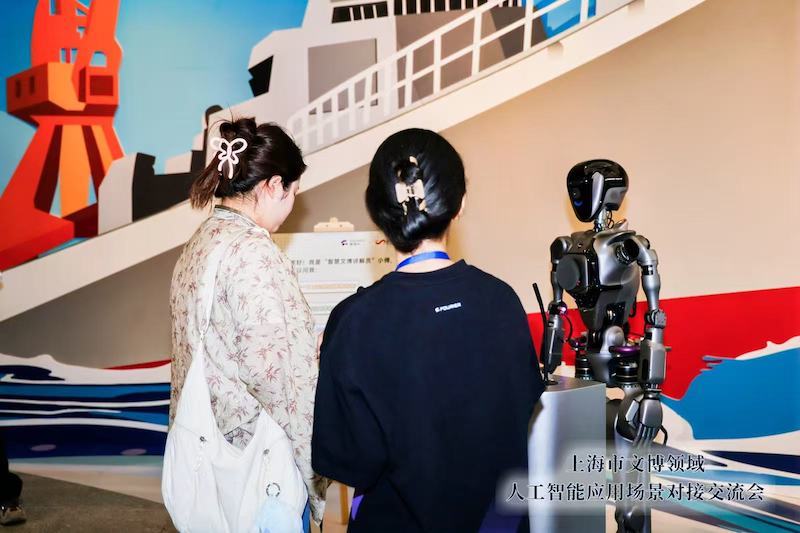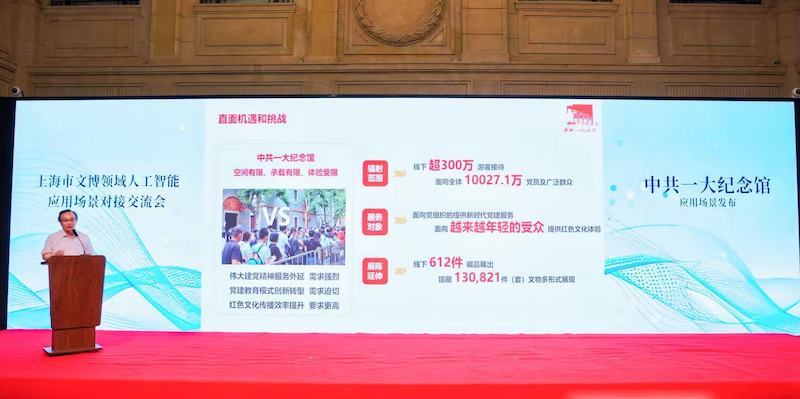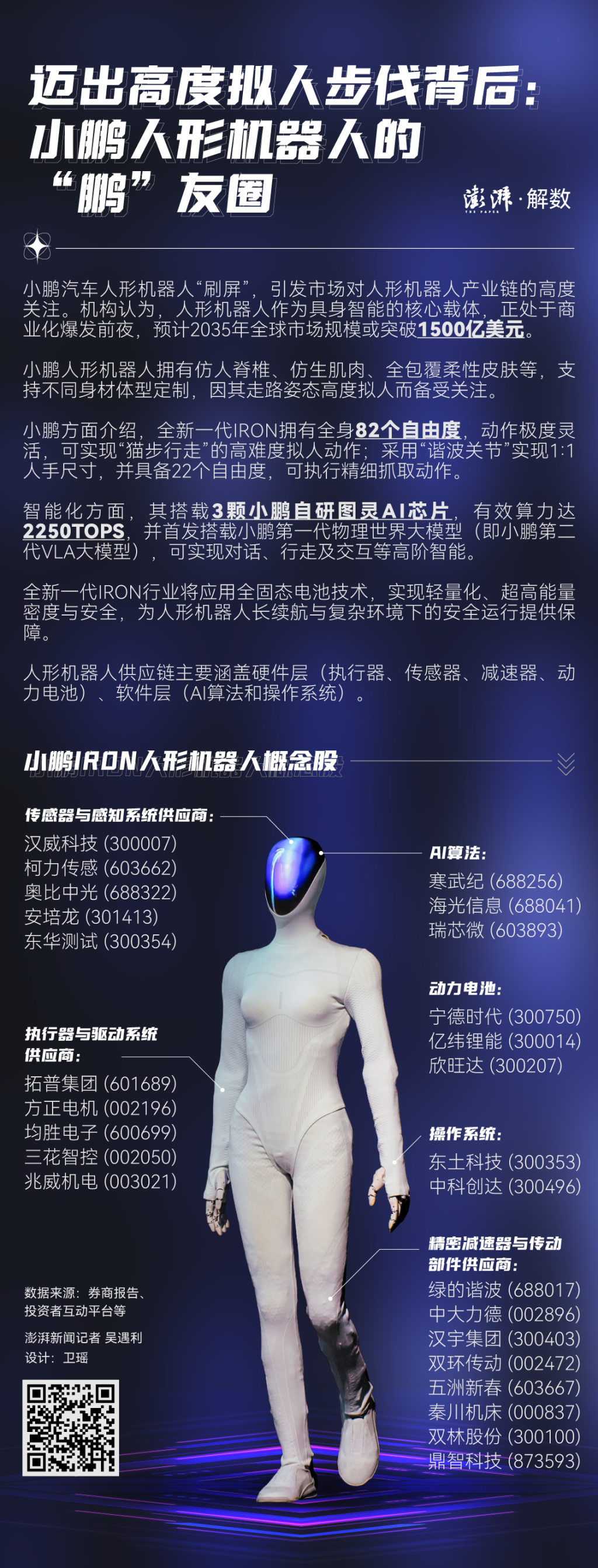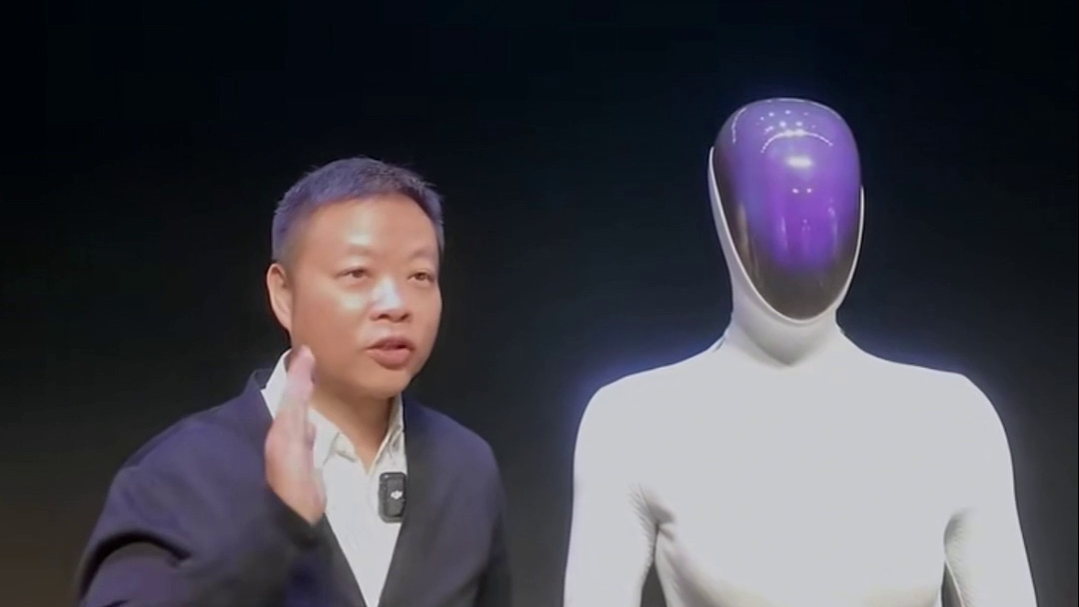
On August 25th, the 2025 Shanghai Artificial Intelligence Application Scenarios Docking and Exchange Conference for the Cultural and Museum Sector was held at the Shanghai History Museum. From guided tours to cultural relic preservation and restoration, cultural and creative development, and the creation of immersive exhibitions, what possibilities lie ahead for AI applications in the cultural and museum sector?
"Xiao Fu, please tell me about the history of the Shanghai History Museum."
"Xiao Fu, can you tell me what the most valuable treasures of the Shanghai History Museum are?"
In the lobby of the Shanghai History Museum, staff from Shanghai's cultural and museum institutions gathered to admire a rising star in the technology world: a "humanoid robot." After preliminary training with corpus data, it has transformed into a "smart cultural and museum guide," vividly explaining precious collections like the "HSBC Bronze Lion" and the "Wuhua Hao Hundred Sons Sedan Chair." It can also answer questions from the audience. Perhaps in the near future, similar "humanoid robots" will enter Shanghai's cultural and museum venues, offering unexpected encounters with visitors.

The scene of the Shanghai Cultural and Museum Artificial Intelligence Application Scenario Docking Exchange Meeting
On August 25th, the 2025 Shanghai Artificial Intelligence Application Scenarios in Cultural and Museum Sector Matchmaking and Exchange Conference was held at the Shanghai History Museum. A live demonstration of a humanoid robot, a collaboration between SenseTime and Fourier Robotics, captivated visitors. "Through this on-site demonstration, we're also interested in understanding the specific needs of cultural and museum scenarios and the potential for its future applications in the field," said a Fourier Robotics staff member. "By integrating large-scale models with embodied intelligence, the humanoid robot can precisely adapt to complex scenarios such as cultural and museum tourism, continuously optimizing the guiding and consulting experience and supporting the implementation of intelligent services in venues."

The scene of the Shanghai Cultural and Museum Artificial Intelligence Application Scenario Docking Exchange Meeting
According to reports, Shanghai is currently accelerating the application of artificial intelligence in the cultural and museum fields, focusing on cultural relics protection and restoration, cultural relics identification, venue guidance, immersive exhibitions, etc., promoting the creation of a number of intelligent application scenarios, and actively exploring innovative ways to make cultural relics "come alive" and shape new cultural experience methods.
Shanghai's application of artificial intelligence in cultural and museum fields began early, pioneering and setting new trends. In 2018, the Shanghai Museum built China's first comprehensive data-based digital management platform; in 2021, the Shanghai History Museum launched the city's first digital twin museum system, significantly enhancing the museum's digital governance capabilities. A number of benchmark projects, such as the "Wind Rising in Luoyang" immersive experience, "The Lost Pharaoh: An In-Depth Immersive Exploration of the Pyramid of Khufu," and "Digital University: A Journey to the Beginning," China's first LBE VR immersive exhibition on red culture, leverage AI to create digital twins of cultural relics and create cross-temporal narratives. These projects are revitalizing Chinese civilization through algorithmic empowerment and continuously injecting new momentum into urban consumption upgrades and economic and social development.

The scene of the Shanghai Cultural and Museum Artificial Intelligence Application Scenario Docking Exchange Meeting

The scene of the Shanghai Cultural and Museum Artificial Intelligence Application Scenario Docking Exchange Meeting
At the matchmaking conference, several AI application scenarios for cultural and museum products were officially launched and signed at a signing ceremony. The Shanghai Museum and BesTV are collaborating to create a digital twin museum. Integrating AIGC and ultra-high-definition technologies, and leveraging cultural and museum datasets, this project aims to bring cultural relics into the hands of millions of people through more vivid presentations and immersive interactive experiences. The Memorial Hall of the First National Congress of the Communist Party of China is actively promoting AI-powered red culture, planning and developing a large-scale model called "Chuguang," and signing a contract with China Telecom to jointly develop the "Digital First National Congress" project, a generative AI design service subsystem for red cultural creation and dissemination. The Shanghai History Museum, in partnership with four tech startups, will continue to deepen collaboration in areas such as spatial scanning, agile acquisition modeling, digital copyright protection, and intelligent tour guidance. By establishing a joint laboratory, they will establish a comprehensive "technology R&D - application demonstration - promotion and replication" model. The Shanghai Cultural Relics Exchange Center (Shanghai Cultural Relics Store) and Shanghai Kupas Technology Co., Ltd. signed a framework agreement to explore the development of a portable cultural relic corpus based on the cultural relics collected and stored by the Shanghai Cultural Relics Exchange Center (Shanghai Cultural Relics Store).

The scene of the Shanghai Cultural and Museum Artificial Intelligence Application Scenario Docking Exchange Meeting
At the conference, Shanghai Jiao Tong University officially launched the "Shanghai Collaborative Research Center for Cultural Heritage Architecture and Artificial Intelligence," a project established by integrating its resources. Leveraging the Shanghai Jiao Tong University Center for Smart Humanities and Social Sciences and the International Research Center for the Preservation of Architectural Cultural Heritage, the center focuses on empowering AI technology in core areas such as diagnosing damage to cultural heritage buildings, predicting risks, and making conservation decisions, ultimately driving the intelligent advancement of cultural heritage conservation.
During the corporate display and promotion session, many technology companies shared their intelligent cultural and museum research and development results and products, using Chinese AI to tell the story of Chinese cultural and museum.
The atmosphere during the presentation and negotiation sessions was lively, with businesses and cultural institutions actively exploring the diverse possibilities of AI-enabled business. Fourier Robotics demonstrated the innovative experiences that embodied intelligence can bring to cultural and museum venues. Bimo AI, through its multimodal AIGC interactive terminal, has been successfully implemented in numerous cultural and tourism venues, including Shanghai Tower, Hongyadong Cave, Sanxingdui Museum, and Qingzhou Museum. Xinke Animation, a leading provider of LBE large-scale spaces in China, covers the development and operation of the entire cultural and tourism metaverse industry chain. Its exclusively licensed VR large-scale space project, "The Mysterious Western Xia Tombs," launched at the Shanghai Museum of History in September 2024, receiving positive public response.
This matchmaking exchange meeting was hosted by the Shanghai Municipal Administration of Culture and Tourism and the Shanghai Municipal Administration of Cultural Heritage, and co-organized by the Shanghai Museum of History and the Shanghai Artificial Intelligence Industry Association. The organizers stated that going forward, the Shanghai Municipal Administration of Culture and Tourism will fully implement the "Shaping Shanghai" strategic plan, continue to deepen the cross-sector integration of artificial intelligence and cultural tourism, and strive to build a new ecosystem and new form of cultural tourism in the digital age. By strengthening policy guidance, expanding application scenarios, and enhancing cross-sector cooperation, the Administration will accelerate the development of a number of replicable and scalable "AI + Cultural Tourism" benchmark cases, creating a globally influential highland for smart cultural tourism practices. In this city, brimming with innovation and vitality and rich in cultural heritage, citizens and tourists will deeply experience the new Shanghai landscape of the integration and coexistence of technology and culture.

